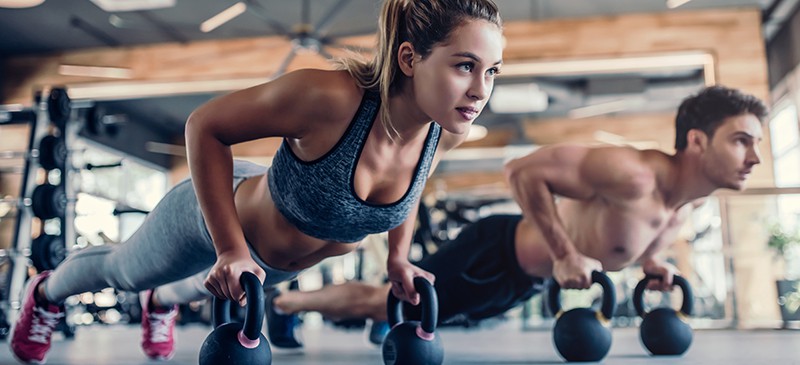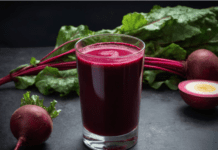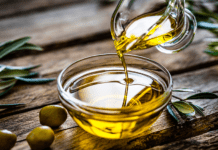
High-intensity interval training, also called HIIT workouts, has become known in the fitness and medical world as one of the most effective means of improving cardiovascular health, respiratory endurance, as well as metabolic function.
Research shows that HIIT workouts help burn fat in a short period of time and improve the physical performance of athletes of all kinds.
In fact, HIIT workouts have the ability to transform your body and physical abilities due to their effect on at least three important systems within the body:
- Your cardiovascular health and endurance
- Your body’s ability to use oxygen
- Your hormone levels
For most people, because it’s one of the great metabolism boosters, the biggest draw to a HIIT workout is its ability to keep the body burning fat even after the workout is over.
What Is HIIT?
High-intensity interval training is a type of exercise that involves repeated short bouts of high-intensity, or “burst” exercises, followed by brief recovery periods.
This sequence is repeated several times in a row usually for a duration between 20–30 minutes.
The exact type of exercise performed during the “intense” internal periods can vary, such as performing sprints or doing faster reps of a particular move.
A popular example of a HIIT workout can be running on the treadmill, alternating between a very fast pace and one that is easier and slower.
In order to follow an interval schedule, you switch between sprints that require roughly 90 percent of your energy, followed by walking or slowly jogging to rest and recover.
Steady-state exercises, on the other hand, usually stay within the same type of “work” zone over time, with the amount of effort needed remaining consistent.
Considering the fact that many people use “not having enough time” as a popular reason to avoid regularly exercising, HIIT workouts are one of the best ways to overcome this block and get great results fast.
A HIIT protocol is a well-researched way to reap physical benefits as an alternative approach to steady-state exercise training but with less of a time commitment.
For example, recently a study compared the impact of two different types of exercise training on body fat and muscle metabolism: HIIT workouts versus steady-state exercise.
The study investigated the effects of calorie expenditure and fat loss in young adults and found that although HIIT workouts actually burned fewer calories during the actual workouts than did steady-state cardio exercise (likely due to its shorter duration), the HIIT program produced more fat loss than steady-state exercise did overall.
Additionally, the study concluded that while the HIIT workout helped build muscle, the steady-state workouts actually broke muscle down.
Researchers concluded that not only does HIIT burn more fat over the duration of the day, but it also builds more muscle and improves metabolic function.
Two awesome perks of HIIT workouts are that depending on the type you choose, you can perform the workouts in the comfort of your own home without a trainer or gym … and they can target all areas of your body, from your legs to your arms to your abs.
HIIT Workout Benefits
1. Improves Type 2 Diabetes
Studies have shown that resistance-based interval training specifically benefits blood flow and blood vessel dilation.
A study, published in the American Journal of Physiology-Heart and Circulatory Physiology, found that resistance-based interval exercising improved endothelial function in individuals that previously exercised, those that didn’t and those with type 2 diabetes.
When researchers measured blood flow before, immediately following and at one and two hours after working out, participants with type 2 diabetes saw improvements at each time.
The other two participant groups experienced improvements one and/or two hours after exercising.
2. Boosts Cardiovascular Health
Many studies are now showing that internal training — including HIIT workouts — promote greater improvements in VO2max and general fitness abilities than steady-state exercises do.
In fact, VO2max is considered the best indicator of cardiovascular endurance.
This is the measurement most commonly used in fitness studies to show the effects that the exercise is having on the body.
VO2 max is sometimes also called “max oxygen uptake” or “max aerobic activity” and is used to measure how well the body can use oxygen for energy.
Specifically, VO2max is defined as the maximum amount of oxygen (in milliliters) that a person can use in one minute per kilogram of their body weight
. This measurement is important because the amount of oxygen that a person can utilize within one minute is an indicator of their overall fitness level and also their lung and heart health.
Due to the expansion of blood volume, the heart will undergo enlarging, or “hypertrophy,” during HIIT type of endurance exercises in order to allow the heart muscle to become bigger and stronger.
By pushing your heart rate high during periods of intense work, you’ll be able to increase your cardiovascular ability and strengthen your heart.
During the short rest intervals, you work on recovering more quickly and needing less time to rest.
This is how you build stamina over time and increase your ability to perform physical exercises more effectively.
Performing short recovery segments in between the intervals where you’re working harder has the benefit of allowing you to keep the overall workout intensity high while still maintaining form.
While it’s hard to work very hard and maintain a high heart rate for an extended period of time because your body isn’t able to bring in enough oxygen, the rest/recovery periods of interval training allow you to catch your breath and for your heart rate to come down momentarily.
Knowing your VO2 max can help you to establish fitness goals to work towards and gives you a starting point as to how capable you are of maintaining a high level of effort over a period of time.
3. Triggers An Excess Post-Exercise Oxygen (EPOC) Effect
HIIT workouts also trigger something known as excess post-exercise oxygen consumption, or “EPOC.” EPOC is the phenomenon of an increased rate of oxygen that your body uses following strenuous activity.
Your body uses more oxygen after hard workouts like those performed during HIIT because it’s making up for the body’s “oxygen deficit” that occurred during the difficult “burst” periods of the exercise.
EPOC has many functions for the body, including that following a HIIT workout, your body goes into a recovery phase.
A higher level of oxygen is needed during recovery in order to facilitate the restoration of hormone levels, refueling your glucose stores, and repairing your muscle fibers and tissue.
The best part about EPOC? It’s accompanied by an elevated need for bodily “fuel” or energy in addition to more oxygen.
After intense exercise, fat stores within your body are actually broken down and free fatty acids are released into the bloodstream.
During the post-workout recovery phase, these free fatty acids become oxidized and your body uses them for energy.
As your body uses more oxygen to bring itself back into a resting state, more calories are burned in the process, even while you are done working out.
This means you continue to experience benefits and fat loss during the remainder of your day following a HIIT workout.
Another benefit of EPOC that results from HIIT workouts? New ATP (adenosine triphosphate) — which is the fuel source of energy that your body works off of — is also synthesized.
Additionally, post-exercise oxygen is used to reduce lactic acid.
Lactic acid is formed during exercise and is responsible for giving you the “burning” feeling in your muscles when they are working hard.
Lactic acid travels via the bloodstream to the kidneys, cardiac muscle, and liver during workouts; then an increased amount of oxygen is necessary to convert the lactic acid back to pyruvic acid so that your pain subsides and the body enters a resting state.
Yet another use of EPOC is to fuel the body’s increased metabolism that results from the increase in body temperature experienced during exercise.
Due to all of these vital tasks that the body must undergo during a period of EPOC, you can see why HIIT workouts have such a huge effect on your strength, stamina, and health.
4. Releases Muscle-Growth and Fat-Burning Hormones
Intense interval training circuits also stimulate muscle-building hormones while simultaneously using up calories and burning fat.
The body produces the growth hormone known as IGF-1 during HIIT, for example, which allows the body to build lean mass muscle.
5. Anti-Aging
According to a paper presented at the 2012 European Society of Cardiology annual meeting:
- There is a direct relationship between physical activity and life expectancy
- Exercise can activate telomerase, a well-known anti-aging enzyme
- A single workout can activate telomerase in circulating cells
- High-intensity interval training increases telomerase as well as reduces p53 expression, a very interesting protein in humans that contributes to premature aging and tumor suppression
In addition to affecting DNA, the wide variety of anti-aging HIIT benefits include:
- Firmer skin/fewer wrinkles
- Increased energy
- Boosted metabolism
- Improved libido
- Muscle tone improvement
- Reduced body fat
6. Helps Balance Hormones (3 Key Ones)
In addition to being “anti-aging,” a critical benefit of high-intensity interval training is that it can help balance the hormones responsible for weight gain and unhealthy eating habits:
- Ghrelin – the hormone responsible for long-term weight gain and short-term eating habits, as it is believed to be the only hormone that can stimulate the appetite. Essentially, it’s the main contributor to sweet, salty, and fried food cravings.
- Leptin – known as the “starvation hormone” because it gives you a sense of feeling “full.” By notifying your brain that you have eaten enough food, leptin is key to maintaining that your energy levels are sufficient.
- Testosterone – four facts about testosterone’s confusing interactions with the two above hormones include 1) elevated levels of testosterone promote weight loss; 2) testosterone inhibits the release of leptin in the body; 3) decreased levels of leptin promote weight gain; 4) both hormones have been observed to increase after HIIT.
In theory, high-intensity interval training produces a seesaw effect on these two key hormones (testosterone and leptin) that usually counteract against each other, but promote the same desirable weight loss effect.
The question has been, “Would the amount of leptin produced as a result of HIIT be enough to counteract testosterone’s ability to slow down leptin release?”
Well, according to a study published in the journal Endocrine, the answer is yes.
Apparently, high-intensity workouts promote a very unique environment where leptin is relatively impervious to the negative effects of testosterone elevation, as no relationship between the two could be found in a clinical trial.
By doing HIIT training exercises, you receive the benefit of both weight-loss promoting hormones.
In addition, Health and Exercise Science researchers out of the University of Bath (UK) have shown that various hormone levels in individuals who participated in burst training resulted in:
- Ghrelin declines after 30 min of recovery.
- Caused growth hormone (a hormone attributed to weight loss) to increase, which suggests that burst training affects other hormones in addition to ghrelin and leptin.
Just two from a myriad of research studies, it is becoming clearer than ever that high-intensity interval training is quite effective at curbing several appetites and weight gain hormones
Important Note:
Like any activity, it is important to perform it in the most effective way.
The same is true for high-intensity interval training.
To maximize your HIIT training, it is best to exercise first thing every morning to control gherlin and leptin.
According to a study published in the Journal of Physiology, exercising on an empty stomach has also been shown to improve glucose tolerance and insulin sensitivity.
Not only contributing to type 2 diabetes prevention and weight loss, but this has also been proven to curb the munchies and the desire to eat unhealthy snacks in conjunction with ghrelin and leptin.
Who Are HIIT Workouts For?
Certain studies have shown that high-intensity exercise can be potentially unsafe for sedentary middle-aged adults.
It’s best performed by those who are already somewhat active and have a healthy cardiovascular system.
That being said, anyone can work towards practicing HIIT workouts for their multiple benefits.
However, if you aren’t already exercising, then it’s best to start slowly to avoid injury or more serious problems.
In conclusion, an exercise plan that includes consistent high-intensity interval exercise has been shown to improve body composition, boost cardio-metabolic health, lessen the risk for heart disease, and help improve exercise tolerance, even in obese and overweight participants.
Research has shown that HIIT workouts are safe, efficient, well-tolerated and could help to improve adherence to exercise training given the limited time commitment that they require.
How to Build Your Own HIIT Workout
No matter what your exercise preference is — whether running, biking, swimming, or lifting weights, for example — you can practice HIIT workouts to improve your abilities.
Even seasoned athletes use HIIT workouts to gain stamina and bust through plateaus that they are experiencing after practicing one particular type of exercise for a long time.
HIIT workouts are a great way to “shock” your muscles and to kick your body into high gear, allowing you to continue experiencing results and improvements after your body has gotten accustomed to your usual workout routine.
According to studies, it’s believed that an optimal HIIT workout produces maximum cardiovascular benefits when athletes spend at least several minutes per session in their “red zone” — this generally means reaching at least 90 percent of maximal oxygen uptake (VO2max).
In order to estimate when you are working at 90 percent of your VO2max, you can think about your level of perceived effort on a 1–10 scale; you should be aiming to give it “your all” and reach a score of nine out of a possible 10 for at least a few minutes during a 20–30 minute HIIT workout.
In addition to focusing on your perceived level of effort and targeting a high VO2max, there are also other variables to consider.
Keep these physiological variables in mind, which researchers have noted are all-important for practicing HIIT workouts and continuing to show improvements:
1. The amount of time you spent in your “intense” working interval
The longer you spend in your intense zone, the more of an effect the exercise will have. Start off with shorter bursts of intense periods and increase the duration as you build strength and stamina.
2. The amount of time you spent in your “rest” and recovery interval
You will likely notice that you need less time to recover as your body adapts to HIIT workouts.
Pay attention to how long of rests you are taking and aim to shorten the restful period duration as your abilities improve.
3. The number of reps you perform during your intense bursts
Instead of aiming to improve the duration of time you spend in an intense interval, you can also focus on how many reps you are able to do in each set, for example, or your speed of work.
You will likely notice your ability to do reps quickly improves as you become accustomed to HIIT workouts and that you need less recovery time in between sets.
You may also notice that your sprints get quicker or your cycling pace gets faster if you choose to run or bike during your HIIT workout.
4. The total number of interval series you are able to perform
It’s a good idea to start out with about 15–20 minutes of HIIT intervals and work your way up to 25–30 minutes if you’d like.
The more your body gets used to the intensity, the more series you’ll be able to perform and your total workout length will increase.
5. The time needed between HIIT workouts
Most experts recommend practicing HIIT workouts 2–3 times per week, but not much more than this.
The body needs an adequate break period between HIIT workouts to fully repair and grow stronger.
In fact, this is just as important as the workout itself and if you fail to properly give yourself enough rest, you miss out on some of the benefits of HIIT.
That being said, you will improve your ability to practice HIIT workouts closer to each other as your recovery periods become shorter.
Even after you’ve seen great improvements, it’s still best to allow 48 hours in between HIIT workouts and avoid practicing them multiple days in a row.
4 HIIT Workouts
Keeping all of the above factors in mind, you can start practicing HIIT workouts using one of these example plans:
1. Treadmill Running HIIT Workout
- Start with a warm-up by lightly jogging for three minutes.
- Next, move into your interval period for about 10 minutes. Each minute you will do 20 seconds of intense work followed by 40 seconds of recovery.
- (Do this 10 times to start out, and as you become more fit you can increase to 15 minutes and beyond. If you’d like to challenge yourself more, do 30 seconds of intense bursts followed by 30 seconds of rest.)
- Cool down with a 3-minute jog.
2. Cycling HIIT Workout
This cycling interval workout is based on the “tabata” style of exercise, which usually consists of 20 seconds of hard work followed by 10 seconds of rest.
In order to do interval training, this same ratio can be used in any other form of exercise as well.
- Start by cycling at a restful pace for three minutes to warm up.
- Move into your interval period for the next 10 minutes, where you will be cycling as hard as you possibly can for 20 seconds and then resting for 10 seconds. You can use a timer to keep track of the time or count in your head. Repeat this interval schedule 10–20 times depending on your abilities and current fitness level.
- Cool down with a slow, restful three minutes of cycling.
3. Circuit Training HIIT Workout
The three exercise moves below will make up your “intense” interval, then performing an easier form of cardio afterward will make up your “rest” interval.
- Perform the following three exercises moves back-to-back according to these reps: Start by doing 10 reps of each, then repeat the cycle doing 15 reps of each, then repeat the cycle doing 20 reps of each. Don’t take any breaks until after you’ve gone through all three sets.
- Burpees
- Mountain Climbers
- Jumping Jacks
- (In place of these 3 moves, you could also try performing fast alternating lunges, push-ups or kettlebell swings.)
- After you’ve completed these three sets, do a form of steady-state cardio for about three minutes. This can mean jogging, running in place, hopping on an exercise bike, etc. You want to be working at about half of your ability.
4. Advanced HIIT Workout
Go through each move described below for an intense 20 seconds, moving very quickly through as many reps as you can perform in 20 seconds (really push yourself here!), followed by 10 seconds of rest and taking it easy.
Then jump right into the next move following the same timing. It’s a quick transition. Once you’ve completed each move below, you are done with one intense interval.
- Push-ups
- Bodyweight Rows
- Squats
- Jumping Rope
- Burpees
- Jumping Jacks
- Running in Place
- Medicine Ball Chest Passes
- Jumping Lunges
- Planks (side, high or low)
Rest for two minutes after the circuit is complete. Then go through the entire circuit another two times, or until you lose proper form (which is a sure sign to stop, as you want to prevent any possible injuries).








